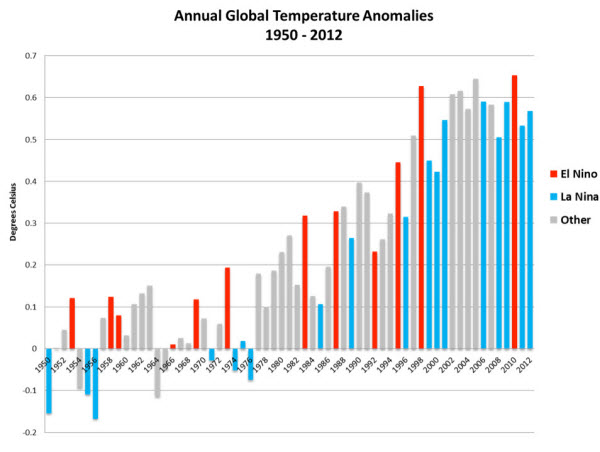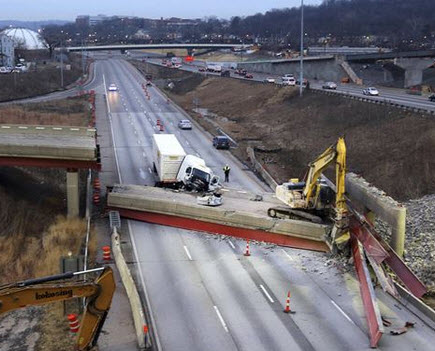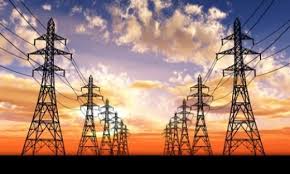“A human role in climate change is acknowledged by every single prominent climate skeptic” admits an article in the conservative Weekly Standard magazine. An op-ed in The Wall Street Journal acknowledges “that carbon-dioxide levels in the atmosphere have increased due to the burning of fossil fuels, and carbon dioxide in 
the atmosphere is a greenhouse gas”. The featured article in the Wall Street Journal‘s weekly “Review” section said climate change is a “settled matter” and that “humans are influencing the climate… due largely to carbon-dioxide emissions from the conventional use of fossil fuels… is no hoax”.
So what’s happening? Are the global warming deniers (who prefer to be thought of as skeptics) throwing in the towel? The answer to that is ‘no’, witness that the titles of those articles were “Climate Cultists”, “…Flat Wrong on Climate Change” and “Climate Science Is Not Settled”.
Nevertheless, the skeptics seemed to have evolved from earlier absolutist positions. But their decades-long campaign to paint global warming, climate change and human involvement in both as a fraud has been so successful that they have left behind broad swaths of the population — and the politicians who pander to them — still believing original doctrine. As recently as this past June the Pew Research Center found that 26% of the public think there is no “solid evidence that the average temperature on Earth has been getting warmer over the past few decades”. Those beliefs hew to partisan lines: 46% of Republicans agreed with that statement compared to 11% of Democrats. Newly crowned Senate Majority Leader Mitch McConnell says, “For everybody who thinks it’s warming, I can find somebody who thinks it isn’t”. Likely seeker of the presidency Senator Marco Rubio, Republican of Florida, rejects outright that climate change is caused to a significant degree by human activity. And James Inhofe, the new chair of the Environment and Public Works Committee, which (of all things) oversees the Environmental Protection Agency, famously called global warming “the greatest hoax ever perpetrated on the American people”.
He said that back in 2003, however. How about now? In 2012 he published a book with “The Greatest Hoax” in the title and scolded us with, “God is still up there. The arrogance of people to think that we, human beings, would be able to change what He is doing in the climate is to me outrageous”.
looking for something else
To combat climate activists, the dissidents devote their energies to finding fault in the research of others. The earnest work by scientists worldwide is met with derision from naysayers who call it a “climate industry” seeking to perpetuate research grants and paychecks.
A recent Journal op-ed was devoted entirely to tracking down and debunking the (multiple, as it turns out) sources of the claim that 97% of scientists believe that climate change is man-made. The notion that warming is caused by variations in the Sun’s energy was another attempt to decouple Man as cause. That claim still crops up despite findings that the variations were not strong enough to account for heat rise.
Or maybe it’s the Earth’s wobble. Texas Representative Steve Stockman was incredulous to learn when questioning a White House official that the Earth’s wobble, which is credited with ending ice ages, was left out of climate computer models. That had to be put to rest in another op-ed, this one in The New York Times, by a NASA scientist who wrote, “The time scales involved are on the order of tens of thousands to hundreds of thousands of years… we don’t normally include these factors in 100-year climate projections”.
upgrade
Not so easily dismissed by the climate-concerned is the gift that Inhofe’s God gave the skeptics by keeping the temperature comparatively stable over the last dozen-or-so years, a plateau that has put climate scientists 
on their back foot, unable to explain it except to theorize that warming has shifted from the atmosphere to ocean depths. This has caused some gloating, as from Journal columnist Holman Jenkins noting how “thoroughly the bottom has fallen out of such efforts directly to link human greenhouse-gas emissions and global average temperature”. The hiatus has even caused some notable skeptics, such as Richard Lindzen and Pat Michaels, to conclude that we’ve already seen most of the temperature rise that is likely, never mind a future of ever-increasing greenhouse gas emissions.
Climate activists are quick to point out that while there may be a plateau, it is a high one. The 2007 report from the U.N.’s Intergovernmental Panel on Climate Change (IPCC) had already said that the 1990s was the warmest decade on record. Then came the 21st century, with its first 13 years among the 14 hottest on record. And now the Japanese Meteorological Agency, the first of the four major global temperature recorders to announce,
has said 2014 was the warmest year on record.
finding fault
Conservative media regularly greet with sarcasm the assessments issued every five or six years by the “self-selected scientists” and “self-appointed experts” of the IPCC. The “plateau in global average temperature is the biggest embarrassment for a supposed scientific ‘consensus’ since Piltdown Man”, exults The Weekly Standard. About the “jargon-filled” report the magazine summoned Churchill’s quip that “by its very length, it defends itself against the risk of being read”. Having it both ways, it then chides other media for “generating predictable headlines” based only on the summary rather than those 2,000 pages, which anyway are unimpressive for not being an “original scientific inquiry but a wide-ranging literature review”. The IPCC doesn’t pretend otherwise. The assessments are a peer review of the research of hundreds of scientists over the preceding years.
In May, soon after the final release of the IPCC report, the Obama administration issued its own quadrennial National Climate Assessment which the Journal‘s editorial and opinion page dismissed as
“the only political project grandiose enough for President Obama…playing the old classics of unscientific panic…We have now reached the junkie’s-craving phase of the climate-change story, where bigger and more frequent fixes are necessary to keep alive the euphoria of saving the world” from “droughts, floods, heat waves, torrential rains, wildfires, polar-vortex winters and other indicia of the end of day. Good thing we’ve been building that ark in the backyard”.
models not so super?
As outright denial of a warming planet has become a losing proposition, the dissent has focused on the unreliability of the computer models that project the future rising temperatures. Bias is assumed going in, because, while the models are built by different clusters of climate scientists around the world, all are assumed to be united by a common belief in catastrophic global warming. As proof, the deniers feasted on a trove of e-mails leaked from the University of East Anglia in England a few years ago and found what appeared to be the scandalous cover-up of scientists substituting data that better fit what they hoped to prove.
matching the past
More significantly, the skeptics cite how inaccurate the computer models have been. When actual past data is plugged in, the models have had difficulty replicating what actually happened to the climate in those years. Past models missed the rapid warming of the Arctic in recent decades, for example, but when the models were tweaked to match that rise, the rest of the modeled planet grew too hot compared to what actually happened. “Almost anyone would say the temperature rise seen over the last 35 years is less than the latest round of models suggests should have happened”, according to Carl Mears, the senior research scientist at Remote Sensing Systems, a California firm that analyzes satellite climate readings, quoted in The New York Times.
The climate models depend on how a plethora of data streams from the physical world interact and influence temperature and climate. Reworking the weighting of these influences is derisively called “computer knob-twisting” by the denialists — except that is exactly how one arrives at whether a model has things right. The naysayers at The Weekly Standard warn us that the ability to match the past is no guarantee that a model will correctly foresee the future and they come up with what they call “this startling sentence” in the IPCC report: “The ability of a climate model to make future climate projections cannot be directly evaluated.” Well of curse not; the future hasn’t happened yet. It’s an example of how the obvious is played to sow doubt.
cloud cultists
Those contesting the validity of predictions have hit upon the deficiency of one such input to argue that the models can’t be trusted: their failure to account for clouds. “There remain significant errors in the model simulation of clouds”, the IPCC admits in its most recent report. “It is very likely that these errors contribute significantly to the uncertainties in estimates of cloud feedbacks and consequently in the climate change projections”.
Clouds matter because their brightness — their water vapor — reflects sunlight away from Earth. Indeed, our article on geo-engineering recounted the belief that spraying clouds with salt would make them brighter still, the moisture condensing around the salt to make shiny droplets.
Computer models divide the Earth into a grid with a “virtual weather station” at each corner at which atmospheric variables must be calculated. A typical resolution is a grid with each cell 62 miles to a side (100 kilometers). And the models are 3D — they then divide each cell into layers of atmosphere. Once 10 layers deep, more recent models run to 30 layers.
Tighter resolution than 62-mile squares require much higher computational power for models, which already need plenty of juice. The general rule is that halving the dimension of the cell sides, thus quadrupling the number of cells, increases the computer power needed by a factor of 10.
At any level of resolution, clouds are intermittent and constantly on the move and the weather stations in a model must compute across time how the average temperature and humidity produce a cloud canopy.
Much like atmospheric layers are the oceans, for which the climate models also use 30 layers to try to assess what is happening at different ocean depths.
Together, clouds and oceans make for easy targets for deniers to snipe at and use as proof that their complexity means climate models can never be accurate. Cells 60 miles to a side give a distance such as New York City to Washington, D.C., only four cells, yet weather is not uniform in areas that wide, they can assert. And if the models are not accurate, if they can’t be trusted, they should have no influence on policy.
sensitivity
Climate dissidents have excitedly trumpeted some recent scientific papers that factor in the “plateau” and make the case that the temperature rise could be more gradual than earlier predicted. Whereas we added another 25% to our historic contribution of carbon dioxide into the atmosphere over those 16 years, the temperature rise has been minimal compared to the swift 0.9 degree Fahrenheit climb in Earth’s average surface temperature during the final quarter of the last century. Skeptics have used that anomaly to promote the lowest sensitivity estimates in their debate with whom they deem the “alarmists”, estimates that run to as little as a 2 degree Fahrenheit increase from a doubling of CO2 in the atmosphere. What we should therefore focus on, they say, is the climate’s “sensitivity” to carbon dioxide. Emphasis should be to lock down just how much temperature rise occurs per unit of added CO2 and not do anything rash until that is known. It is rather like having been told you have three months to live but then, upon hearing your doctor say it now looks more like six months, deciding the problem’s over, so why not quit taking your meds?
sowing doubt
The climate contrarians do not deal in empirical research. What white papers and studies they do produce are instead critiques and attempts to refute the work of others. That forecasts of more rapid temperature rises did not pan out was an opportunity for condescension in a Journal op-ed that said the doubters might “forgive these modelers if their forecasts had not been so consistently and spectacularly wrong”.
That posture is because their purpose is entirely political; it is to head off any legislation or policy actions that would disrupt the status quo of the hydrocarbon economy and all the wealth it brings. It is notable that the deniers’ new found belief that warming is real but will take longer doesn’t lead them to celebrate the gift of perhaps enough time to head it off. It is a strange phenomenon to watch humans so absorbed in retaining power in government or storing up money in this temporal moment that they seek debating points to ridicule what is so widely thought to be a looming planetary disaster.
After the fault-finding of the Journal article mentioned above, the authors tell us “the science is urgent” but then sagely advise that we “take steps to make climate projections more useful over time” such as a “global climate observation system” that would “generate an ever-lengthening record of more precise observations” with “increasingly powerful computers” to yield “a better understanding of the uncertainties in our models”. That is a political prescription to do nothing while we wait and see — a continuation of the policy of President Bush who for eight wasted years said we needed ever more research.
But Nature has its own timetable and pays us no attention. Whatever it chooses to do, there’s no undo and “no insurance policy in the event we guess wrong” as one Journal letter writer put it.
Jan 25 2015 | Posted in
Energy & Climate |
Read More »





